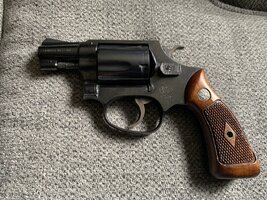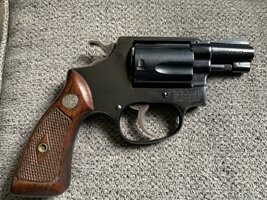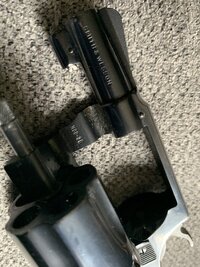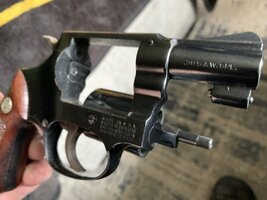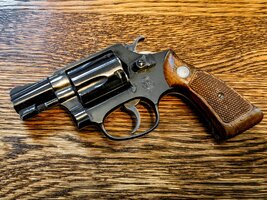Thanks for clarifyingActually he was making a joke. I found it funny. Dry humor doesn't make him a dickhead.
The problem Is when people read those remarks and never fathom they had a big grin when writing it.
-
If you enjoy the forum please consider supporting it by signing up for a NES Membership The benefits pay for the membership many times over.
-
Be sure to enter the NES/MFS May Giveaway ***Canik METE SFX***
You are using an out of date browser. It may not display this or other websites correctly.
You should upgrade or use an alternative browser.
You should upgrade or use an alternative browser.
Model 36 Chiefs Special
- Thread starter Big Buzzy
- Start date
No idea. I’m glad it’s original, but if I was looking to buy it, the finish would not make me want to pay a huge premium. At the end of the day, it’s a very early version of a gun they have made for 70 years; there are tens of thousands of them out there. This is in good shape, but you can buy these old 36s for about $400-$500 all day. That leaves very little room for a condition or rarity premium. I imagine no non-collector is going to pay more than $600 or so for any blued Model 36, or maybe that’s just me. For this one, I wouldn’t go nearly that highThanks. I had it looked at my a certified gun smith. His opinion was original finish. Any idea what it is worth ????
Still, what do I know? Put it up for whatever asking price you want. See what happens.
Thank you. Appreciate the feedbackNo idea. I’m glad it’s original, but if I was looking to buy it, the finish would not make me want to pay a huge premium. At the end of the day, it’s a very early version of a gun they have made for 70 years; there are tens of thousands of them out there. This is in good shape, but you can buy these old 36s for about $400-$500 all day. That leaves very little room for a condition or rarity premium. I imagine no non-collector is going to pay more than $600 or so for any blued Model 36, I assume.
Still, what do I know? Put it up for whatever asking price you want. See what happens.
Asaltweapon
NES Member
I wasn’t being a f***ing dick!! If I was I would have pointed out the sticky that says so.why are there so many smart ass people on this sight. you go to the sight for some info and one or two d****ickheads alway chime in
Eff off.
but to the OP, the value of that gun is as a collectible to someone like me that has a love of old school revolvers.
There was a pristine BNIB 1982 production date Model 19 on here a while ago, original box and the paper the gun was wrapped in.
and when I say pristine it was, and the original owner said it had probably less than 30 rounds put thru it in its entire life.
the gun looked every bit as good as it was described.
That gun sold on here for $600 dollars.
A really nice Model 60, 1980 era production was sold for $400 dollars, with original grips a while back, not a safe queen but a really nice gun
Nobody under the age of 50 is buying a J frame to carry, especially one that isn't going to eat +P ammo
So the market is limited mostly to someone who wants one for nostalgia, I'm 65 and my first carry gun in 1980 was a Model 36 I bought brand new....
then the price point is how much someone is willing to spend for the ability to fondle a piece of their youth.
If it is pristine people may pay a premium, if it is ehh.... they may not want it at all
Personally I'd love a Model 10, but there is a fine line between how much I am willing to spend and the availability of a really nice example.
You see all sorts of guns in the classifieds here that never move, they keep getting bumped, or bumped with a price reduction until the seller finally gives up and puts it back in the safe.
the question is what is it worth to you, and how much would someone have to come up with to make you part with it.
There was a pristine BNIB 1982 production date Model 19 on here a while ago, original box and the paper the gun was wrapped in.
and when I say pristine it was, and the original owner said it had probably less than 30 rounds put thru it in its entire life.
the gun looked every bit as good as it was described.
That gun sold on here for $600 dollars.
A really nice Model 60, 1980 era production was sold for $400 dollars, with original grips a while back, not a safe queen but a really nice gun
Nobody under the age of 50 is buying a J frame to carry, especially one that isn't going to eat +P ammo
So the market is limited mostly to someone who wants one for nostalgia, I'm 65 and my first carry gun in 1980 was a Model 36 I bought brand new....
then the price point is how much someone is willing to spend for the ability to fondle a piece of their youth.
If it is pristine people may pay a premium, if it is ehh.... they may not want it at all
Personally I'd love a Model 10, but there is a fine line between how much I am willing to spend and the availability of a really nice example.
You see all sorts of guns in the classifieds here that never move, they keep getting bumped, or bumped with a price reduction until the seller finally gives up and puts it back in the safe.
the question is what is it worth to you, and how much would someone have to come up with to make you part with it.
jct61765
NES Member
The one I have is .32 smith and wesson. I have the original box of ammo and 42 rounds left in the box from the original gentlemen.Model 31 was a 32 long IIRC.
You could get some better responses and probably some interest on the www.smith-wessonforum.com from people who have more interest and knowledge on the subject. There are people who like and collect baby chiefs.
jct61765
NES Member
I have every j frame smith ever made.You could get some better responses and probably some interest on the www.smith-wessonforum.com from people who have more interest and knowledge on the subject. There are people who like and collect baby chiefs.
chris_1001
NES Member
You have been here since 2014 and you are actually asking that question??why are there so many smart ass people on this sight. you go to the sight for some info and one or two d****ickheads alway chime in
You have been here since 2014 and you are actually asking that question??
What are the differences from what he has to the Model 60?there are too many nice Model 60's out there for not much more
For $500, you can get a brand new 637, 638, 642, 442, or other modern stainless J frame, that are lighter and better for +P if nothing else. Probably other things as well.but you can buy these old 36s for about $400-$500 all day
Can't compete if "sentimental value", though.
What are the differences from what he has to the Model 60?
The model 60 is stainless steel. and has the benfits of the many incremental engineering changes.
Thanks. I'd love to see a photo of both like in post #38 (ha ha, 38!), which might show the differences.The model 60 is stainless steel. and has the benfits of the many incremental engineering changes.
Thanks again.
chris_1001
NES Member
And because I have a serious shit posting problem and missed it, It’s “site” not “sight”… I’m so sorry I could not resist!!! I’ll see myself out now…why are there so many smart ass people on this sight. you go to the sight for some info and one or two d****ickheads alway chime in
For $500, you can get a brand new 637, 638, 642, 442, or other modern stainless J frame, that are lighter and better for +P if nothing else. Probably other things as well.
That's wonderful, for people who want newer Smiths. I am not one of those people.
Marty McFly
NES Member
Talk is cheapI wasn’t being a f***ing dick!! If I was I would have pointed out the sticky that says so.
Eff off.
Are they that much different? I thought they were all the same basic gun.That's wonderful, for people who want newer Smiths. I am not one of those people.
Are they that much different? I thought they were all the same basic gun.
In the sense that they all fire bullets, they're all revolvers, and they're the same basic size? Oh yes.
But I generally prefer older things over newer ones. Most people realize Smith & Wesson's fitting and workmanship was better back in The Day, and for me there's nothing like a smoothly tuned old Smith trigger.
I know the pencil barrels and protruding hammers are old-fashioned, but they make me smile when I look at them and they feel right when I handle them. That's worth more than money to me. I'm a guy who likes to LIKE the guns I own; it's not enough that they simply work, or I'd buy Glocks. The modern Smith versions are reliable, yes, and +P is a thing if you care about it, but I feel supremely confident when carrying all my old Smith snubbies. I like them to have a history, to know they've been around awhile, and that others relied on them before me.
Asaltweapon
NES Member
Who else was better person to give you a valid value? The guy with the gun in his hand or some pictures taken in god knows where?Talk is cheap
Was GunBroker too hard?
JFC.
So the earlier post that said they were just incremental changes was not 100% correct? Again, I thought these were all identical going back through the years, except for maybe different steels and tiny things like knurling or something.In the sense that they all fire bullets, they're all revolvers, and they're the same basic size? Oh yes.
So the triggers are not made identical to how they used to be made? That is a new one on me also. Again, I thought they are all made from the same blueprint.But I generally prefer older things over newer ones. Most people realize Smith & Wesson's fitting and workmanship was better back in The Day, and for me there's nothing like a smoothly tuned old Smith trigger.
Same here.I know the pencil barrels and protruding hammers are old-fashioned, but they make me smile when I look at them and they feel right when I handle them.
So the earlier post that said they were just incremental changes was not 100% correct? Again, I thought these were all identical going back through the years, except for maybe different steels and tiny things like knurling or something.
There were many, many changes in all the Smith models over the years. They're not at all identical; looking at a pic of a modern Model 36 and the OP's piece will show you several differences obvious to the naked eye, and several others internally. They're on at least the tenth version of it around now. That's at least ten changes significant enough to alter the production line, but it's probably many more than just ten changes. Different versions usually incorporated many tiny changes to a number of parts.
So the triggers are not made identical to how they used to be made? That is a new one on me also. Again, I thought they are all made from the same blueprint.
Revolver craftsmen, like most other craftsmen in the world, had a lot more handwork to do back then. Milling, finishing, and inspections were all done by hand and eye instead of by CNC and lasers, meaning it's undeniable that the men who made these revolvers back then knew much, much more about the nuance of their function than any modern employee does. They had to have a much better understanding of the reasons why the parts went together as they did. Tolerances were more closely guarded, because the men who made them spent more time getting them within spec.
Again, modern versions are obviously made well enough, and the designs are inherently reliable. But the older methods, I think, result in a superior product. That might just be my perception, but if it's my money I'm spending? My perception matters.
In addition, the world of gunmaking seventy years ago was a world of forged and milled steel, not a world of cheaper modern sintered steels or imported alloys. I tell myself that makes a difference, though I'm no expert.
Michelle Obama hates America. nfw would she campaign to run it.
Maybe. I've been looking at 60's. Lots of the .38's for sale around $500 up to $800. The .357 versions are closer to high $600's - $800's. But I'm funny like that. I want either a 442 Pro or 640 Pro (no Hilary Hole on either) and both are cut for moon clips. If I got a 60, I'd want it w/o the hole, and then get it cut for moon clips. I like the option of cocking it for single action, if I had to.it is worth what someone will pay for it.
are the grips original? Serialized to the gun?
trace ring around the cylinder?
holster wear ?
Holster wear at the end of the barrel?
Rifling? Forcing cone? blast wear of the finish at the cylinder/barrel interface?
Tight lock up?
Box?
All those things determine value, and nobody is going to put a value on a gun based on pictures without inspecting it.
I love J frames, but they have a limited market, especially older ones that are not going to be able to eat a steady diet of +P ammo
to me is is a $325 dollar gun, there are too many nice Model 60's out there for not much more
Mesatchornug
NES Member
Your answer couldn't be much better nor more accurate without adding actual engineering jargon.There were many, many changes in all the Smith models over the years. They're not at all identical; looking at a pic of a modern Model 36 and the OP's piece will show you several differences obvious to the naked eye, and several others internally. They're on at least the tenth version of it around now. That's at least ten changes significant enough to alter the production line, but it's probably many more than just ten changes. Different versions usually incorporated many tiny changes to a number of parts.
Revolver craftsmen, like most other craftsmen in the world, had a lot more handwork to do back then. Milling, finishing, and inspections were all done by hand and eye instead of by CNC and lasers, meaning it's undeniable that the men who made these revolvers back then knew much, much more about the nuance of their function than any modern employee does. They had to have a much better understanding of the reasons why the parts went together as they did. Tolerances were more closely guarded, because the men who made them spent more time getting them within spec.
Again, modern versions are obviously made well enough, and the designs are inherently reliable. But the older methods, I think, result in a superior product. That might just be my perception, but if it's my money I'm spending? My perception matters.
In addition, the world of gunmaking seventy years ago was a world of forged and milled steel, not a world of cheaper modern sintered steels or imported alloys. I tell myself that makes a difference, though I'm no expert.
@Coyote33, if dimensions were all that mattered, nobody would ever polish internals. Metal Injection Molding and other sintering processes produce parts that are generally both dimensionally accurate and strong enough for their jobs. They are not the same as forged, milled and hand finished parts, however. Despite this, they get used because they're much less expensive in volume.
Once a device is proven and working, if it finds market success, the company asks its designers to do one thing: increase value. This means improving reliability, decreasing manufacturing costs, or adding features. With a revolver like the 36, there aren't a lot of features that customers will want (maybe a hammer block safety or the ability to feed a steady diet of higher pressure loads). The Smith designs were traditionally pretty reliable out of the box, so that's pretty well covered.
That means they're going to focus on making less expensive parts; the fastest route there is to reduce hand finishing. To do this, they'll modify interfaces to produce similar reliability with wider tolerance bands. While they're doing this, they'll tweak the design to allow for different manufacturing processes. Those process will not result in the same class of finish on contact surfaces. Sometimes, this doesn't matter. Others, it does. As long as it still functions, management will say "ship it," even if it leaves the end user to spend additional time/money stoning those surfaces after purchase.
There are lots of benefits to our world of modern manufacturing, but it's also true that "they don't make things like they used to."
TG Pioneer
NES Member
In the sense that they all fire bullets, they're all revolvers, and they're the same basic size? Oh yes.
But I generally prefer older things over newer ones. Most people realize Smith & Wesson's fitting and workmanship was better back in The Day, and for me there's nothing like a smoothly tuned old Smith trigger.
I know the pencil barrels and protruding hammers are old-fashioned, but they make me smile when I look at them and they feel right when I handle them. That's worth more than money to me. I'm a guy who likes to LIKE the guns I own; it's not enough that they simply work, or I'd buy Glocks. The modern Smith versions are reliable, yes, and +P is a thing if you care about it, but I feel supremely confident when carrying all my old Smith snubbies. I like them to have a history, to know they've been around awhile, and that others relied on them before me.
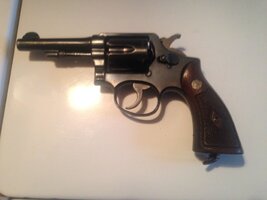
I agree with you 100%. This pre Model 10 was made in 1941. I wish they’d reintroduce this style. When you pick it up, it’s got “something”. Call it a soul, a presence, whatever you want but the new stuff just doesn’t seem to have it.
Garys
NES Member
Or as I would say, they're the same thing only completely different. Like the difference between a 1951 VW Beetle and one made in 1972.
The model 60 is stainless steel. and has the benfits of the many incremental engineering changes.
Share:
Similar threads
- Replies
- 10
- Views
- 166
- Replies
- 171
- Views
- 6K
- Replies
- 34
- Views
- 1K
- Replies
- 28
- Views
- 676

